Toyota 4Runner: Antenna location and effective range
Antenna location
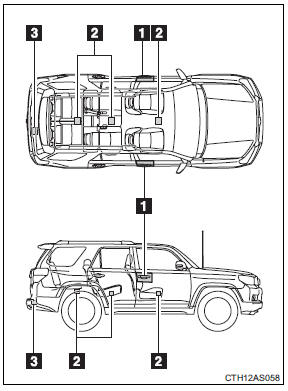
1. Antennas outside the cabin 2. Antennas inside the cabin 3. Antenna outside the luggage compartment
Effective range (areas within which the electronic key is detected)
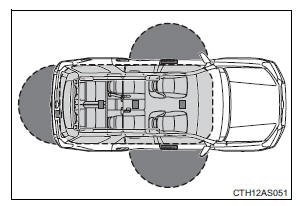
 When locking or unlocking the
When locking or unlocking the
doors
The system can be operated when the electronic key is within about 2.3 ft.
(0.7 m) either of the outside front door handles and back door. (Only the doors detecting the key can be operated.)
 When starting the engine or
When starting the engine or
changing “ENGINE START STOP” switch modes
The system can be operated when the electronic key is inside the vehicle.
Operation signals
A buzzer sounds and the emergency flashers flash to indicate that the doors have been locked/unlocked. (Locked: once; Unlocked: twice)
When the door cannot be locked by the lock sensor on the upper part of the door handle
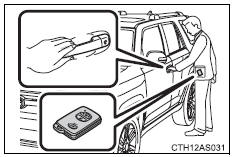
Touch both lock sensors on the upper and lower part of the door handle simultaneously.
Alarms and warning indicators
A combination of exterior and interior alarms as well as warning lights is used to prevent theft of the vehicle and accidents resulting from erroneous operation.
When any warning lights come on, take appropriate measures depending on which warning light comes on.
The following table describes circumstances and correction procedures when only alarms are sounded.
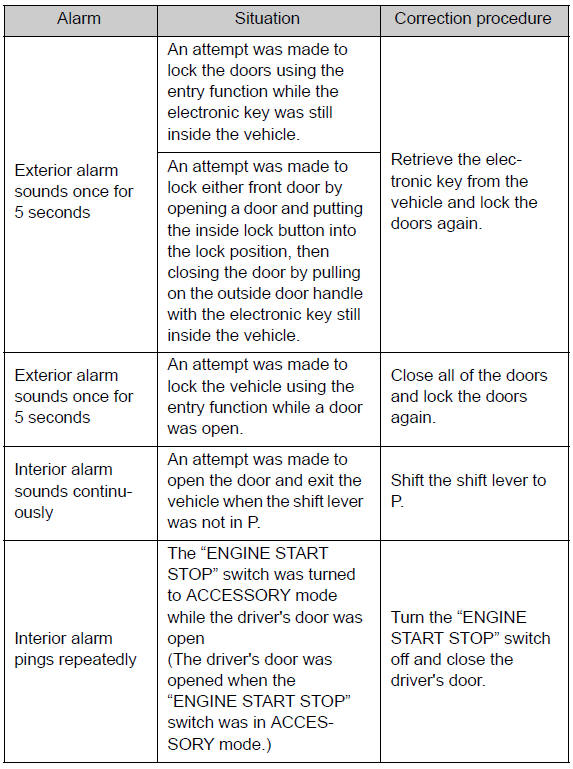
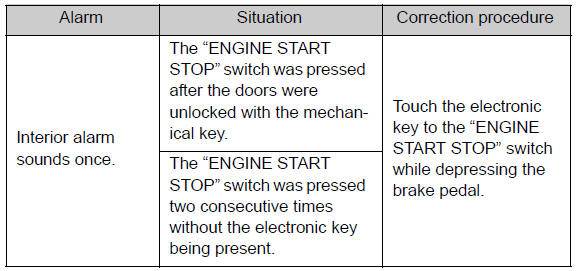
Security feature
If a door is not opened within approximately 60 seconds after the vehicle is unlocked, the security feature automatically locks the vehicle again.
Battery-saving function
In the following circumstances, the entry function is disabled in order to prevent the vehicle battery from discharging and the electronic key battery from depleting.
• When the entry function has not been used for 5 days or more
• When the electronic key has been left within approximately 6 ft. (2 m) of the vehicle for 10 minutes or more
• If the entry function has not been used for 14 days or more, the vehicle cannot be unlocked by a door other than the driver's door. To unlock the vehicle, grip the driver's door handle or use the wireless remote control or the mechanical key.
The system will resume operation when
• The vehicle is locked using the door handle lock switch when carrying the electronic key on your person.
• The vehicle is locked/unlocked using the wireless remote control.
• The vehicle is locked/unlocked using the mechanical key.
Conditions affecting operation
The smart key system uses weak radio waves. In the following situations, the communication between the electronic key and the vehicle may be affected, preventing the smart key system, wireless remote control and immobilizer system from operating properly. (Way of coping )
• When the electronic key battery is depleted
• Near a TV tower, electric power plant, gas station, radio station, large
display, airport or other facility that generates strong radio waves or
electrical noise
• When carrying a portable radio, mobile phone, cordless phone or other wireless
communication device
• When the electronic key is in contact with, or is covered by the following
metallic objects
• Cards to which aluminum foil is attached
• Cigarette boxes that have aluminum foil inside
• Metallic wallets or bags
• Coins
• Hand warmers made of metal
• Media such as CDs and DVDs
• When multiple electronic keys are in the vicinity
• When other wireless keys (that emit radio waves) are being used nearby
• When carrying the electronic key together with the following devices that emit
radio waves
• Another vehicle's electronic key or a wireless key that emits radio waves
• Personal computers or personal digital assistants (PDAs)
• Digital audio players
• Portable game systems
• If window tint with a metallic content or metallic objects are attached to the
back window
Note for the entry function
• Even when the electronic key is within the effective range (detection areas), the system may not operate properly in the following cases:
• The electronic key is too close to the window or outside door handle, near the ground, or in a high place when the doors are locked or unlocked.
• The electronic key is on the instrument panel or floor, in the glove box, or in the auxiliary box of the instrument panel.
• Do not leave the electronic key on top of the instrument panel or near the door pockets when exiting the vehicle. Depending on the radio wave reception conditions, it may be detected by the antenna outside the cabin and the door will become lockable from the outside, possibly trapping the electronic key inside the vehicle.
• As long as the electronic key is within the effective range, the doors may be
locked or unlocked by anyone. However, only the doors detecting the electronic
key can be used to unlock the vehicle.
• The doors may lock or unlock if the electronic key is within the effective range and a large amount of water splashes on the door handle, such as in the rain or in a car wash. The doors will automatically be locked after approximately 60 seconds if a door is not opened and closed.
• If the wireless remote control is used to lock the doors when the electronic key is near the vehicle, there is a possibility that the door may not be unlocked by the entry function. (Use the wireless remote control to unlock the doors.)
Notes for locking the doors
• Touching the door lock sensor while wearing gloves may delay or prevent lock operation. Remove the gloves and touch the lock sensor again.
• When the lock operation is performed using the lock sensor, recognition signals will be shown up to two consecutive times. After this, no recognition signals will be given.
• If the door handle becomes wet while the electronic key is within the effective range, the door may lock and unlock repeatedly. Place the key in a position 6 ft. (2 m) or more separate from the vehicle while the vehicle is being washed. (Take care to ensure that the key is not stolen.) • If the electronic key is inside the vehicle and a door handle becomes wet during a car wash, a buzzer will sound outside the vehicle. To turn off the alarm, lock all the doors.
• The lock sensor may not work properly if it comes into contact with ice, snow, mud, etc. Clean the lock sensor and attempt to operate it again, or use the lock sensor on the lower part of the door handle.
• Fingernails may scrape against the door during operation of the door handle. Be careful not to injure fingernails or damage the surface of the door.
Notes for the unlocking function
• Gripping the door handle when wearing a glove may not unlock the door.
• A sudden approach to the effective range or door handle may prevent the doors from being unlocked. In this case, return the door handle to the original position and check that the doors unlock before pulling the door handle again.
• If there is another electronic key in the detection area, it may take slightly longer to unlock the doors after the door handle is gripped.
When the vehicle is not driven for extended periods
To prevent theft of the vehicle, do not leave the electronic key within 6 ft. (2 m) of the vehicle.
To operate the system properly
Make sure to carry the electronic key when operating the system. Do not get the electronic key too close to the vehicle when operating the system from the outside of the vehicle.
Depending on the position and holding condition of the electronic key, the key may not be detected correctly and the system may not operate properly.
(The alarm may go off accidentally, or the door lock prevention function may not operate.)
If the smart key system does not operate properly
• Locking and unlocking the doors: Use the mechanical key. • Starting the engine:
Electronic key battery depletion
• The standard battery life is 1 to 2 years.
• As the electronic key always receives radio waves, the battery will become depleted even if the electronic key is not used. The following symptoms indicate that the electronic key battery may be depleted.
Replace the battery when necessary.
• The smart key system or the wireless remote control does not operate.
• The detection area becomes smaller.
• The LED indicator on the key surface does not turn on.
• To avoid serious deterioration, do not leave the electronic key within 3 ft.
(1 m) of the following electrical appliances that produce a magnetic field:
• TVs
• Personal computers
• Cellular phones, cordless phones and battery chargers
• Recharging cellular phones or cordless phones
• Glass top ranges
• Table lamps
Precautions when disconnecting the battery
• In some cases, it may not be possible to unlock the doors using the smart key system immediately after the battery has been disconnected. Use the wireless remote control or the mechanical key to lock or unlock the doors.
• The engine may not start on the first attempt after reconnecting the battery but will start normally after the second attempt. This is not a malfunction.
• The “ENGINE START STOP” switch mode is memorized by the vehicle.
When the battery is reconnected, the system will return to the mode it was in before the battery was disconnected. Before disconnecting the battery, turn the “ENGINE START STOP” switch off.
If you are unsure what mode the “ENGINE START STOP” switch was in when the battery was disconnected, be especially careful when reconnecting the battery.
When the electronic key battery is fully depleted
Customization that can be configured at Toyota dealer
Settings (e.g. smart key system) can be changed.
(Customizable features )
Certification for the smart key system
For vehicles sold in the U.S.A.
FCC ID: NI4TMIMB-2 FCC ID: NI4TMLF8-14 FCC ID: HYQ14ACX FCC ID: HYQ13CZD FCC ID: HYQ14ADF FCC ID: HYQ13CZE NOTE:
This device complies with part 15 of the FCC Rules. Operation is subject to the following two conditions: (1) This device may not cause harmful interference, and (2) this device must accept any interference received, including interference that may cause undesired operation.
FCC WARNING:
Changes or modifications not expressly approved by the party responsible for compliance could void the user's authority to operate the equipment.
For vehicles sold in Canada
NOTE:
Operation is subject to the following two conditions: (1) this device may not cause interference, and (2) this device must accept any interference, including interference that may cause undesired operation of the device.
CAUTION
Caution regarding interference with electronic devices
• People with implanted pacemakers or cardiac defibrillators should keep away from the smart key system antennas.
The radio waves may affect the operation of such devices. If necessary, the entry function can be disabled. Ask your Toyota dealer for details, such as the frequency of radio waves and timing of emitting the radio waves.
Then, consult your doctor to see if you should disable the entry function.
• Users of any electrical medical device other than implanted pacemakers and implanted cardiac defibrillators should consult the manufacturer of the device for information about its operation under the influence of radio waves.
Radio waves could have unexpected effects on the operation of such medical devices.
Ask your Toyota dealer for details on disabling the entry function.
 Unlocking and locking the back door
Unlocking and locking the back door
Press the button to unlock the door.
The back window can be opened by pressing and holding this button.
Press the button to lock the door.
The back window can be closed by pressing and holding ...
 Wireless remote control
Wireless remote control
The wireless remote control can be used to lock and unlock the vehicle.
Vehicles without a smart key system
1. Locks all the doors
2. Sounds the alarm (press and hold)
3. Unlocks all the doors ...
Other materials about Toyota 4Runner:
Rear Power Window RH does not Operate with Rear Power Window Switch RH
DESCRIPTION
If the manual up/down function does not operate, there may be a malfunction
in the rear power window regulator switch, rear power window regulator motor,
harness or connector.
WIRING DIAGRAM
CAUTION / NOTICE / HINT
NOTICE ...
Registration
REGISTRATION
PROCEDURE
1. REGISTER TRANSMITTER CODE
HINT:
The vehicle garage door opener records transmitter codes for systems
such as garage doors, gates, entry gates, door locks, home lighting systems,
security systems or other transmitte ...
0.026
